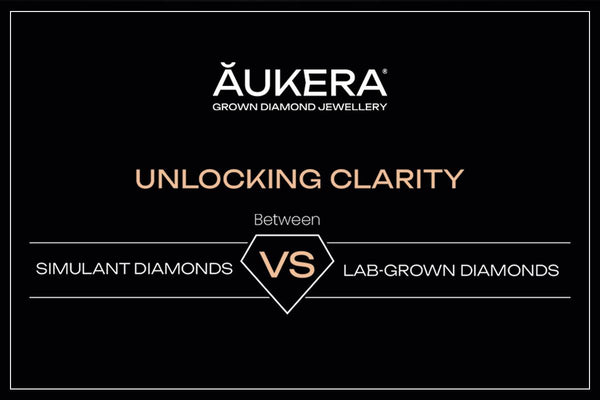
Unlocking Clarity: Discerning Between Simulant Diamonds and Lab-Grown Diamonds
In the sprawling realm of diamonds, where every facet glistens with brilliance and elegance, perfection is paramount. As you navigate the jewellery marketplace, the ability to discern between the types of diamonds available becomes essential, particularly in distinguishing between simulant diamonds and lab-grown diamonds. The two are oftentimes mistaken to be interchangeable, which they are far from.
At Aukera, we believe in empowering you with the knowledge to make informed decisions, ensuring that each of your diamond purchases reflects not only elegance but also authenticity and integrity. Let's delve into the differences between simulant diamonds and Aukera's grown diamonds, shedding light on the unique qualities that set apart the lab grown diamonds from imitating counterparts to guide you to the perfect purchase:
Simulant Diamonds: The Illusion of Brilliance
One thing is clear. SIMULANT DIAMONDS - ARE NOT DIAMONDS. So, what are Simulant Diamonds? As the name itself suggests, simulant diamonds are gems engineered out of materials that mimic the appearance of diamonds but lack the same chemical composition and physical properties. Common simulants include cubic zirconia, American diamonds, moissanite, and white sapphire.
- Cubic zirconia (CZ), a synthetic crystalline substance, is one of the most widely used materials for creating simulant diamonds. It exhibits a high level of brilliance and clarity, closely resembling the sparkle of diamonds.
- Moissanite, another popular choice for simulant diamonds, is a naturally occurring silicon carbide mineral. While moissanite shares some optical characteristics with diamonds, such as brilliance and fire, it has distinct differences in hardness and thermal conductivity.
- White sapphire, a type of corundum, is also utilised as a simulant diamond due to its transparent appearance and hardness. However, white sapphire lacks the same level of brilliance and fire as diamonds.
Simulant diamonds can be found in various jewellery pieces, including rings, earrings, necklaces, and bracelets. They are often used as affordable alternatives to diamonds, offering consumers the opportunity to enjoy the look of luxury without the high cost associated with genuine diamonds. But while simulants may possess a similar sparkle and brilliance to diamonds, a trained eye, and a diamond connoisseur can distinguish between a diamond and Simulant. On closer examination due to differences in hardness, refractive index, and thermal conductivity - anybody can tell these stimulants are not diamonds.
Diamond Simulants: Know the Difference
Diamond simulants, such as cubic zirconia and moissanite, are materials that resemble diamonds in appearance but have different chemical compositions and properties. They are manufactured to mimic the look of diamonds but are not true diamonds.
- Appearance vs. Authenticity: Simulants may look similar to diamonds, but they lack the inherent properties and rarity that make diamonds valuable. Over time, simulants can lose their lustre or become scratched, diminishing their appeal.
- Cost and Longevity: Simulants are generally much cheaper than diamonds, but they also do not hold their value over time. Their affordability may initially seem appealing, but they do not offer the same lasting investment or sentimental value as a genuine diamond.
Discern your Sparkle: How to Differentiate between Simulant and Lab Grown Diamonds
It is important you develop the eye and skills needed to ascertain how the lab grown diamond is different from the simulant. Being knowledgeable during your shopping process promotes transparency and trust when you invest your money in luxury. Simulant diamonds and lab-grown diamonds can often be distinguished through various methods. Here are some ways to differentiate between them:
- Certification: One of the most reliable ways is to check the certification of the diamond. Lab-grown diamonds are often certified as such by reputable gemological laboratories like the Gemological Institute of America (GIA), International Gemological Institute (IGI), or the American Gem Society (AGS). Simulated diamonds like cubic zirconia usually won't have such certifications.
- Brilliance and Fire: While both lab-grown diamonds and simulants can sparkle, lab-grown diamonds often have a higher level of brilliance and fire due to their optical properties. Lab-grown diamonds may exhibit more subtle and dispersed flashes of light compared to the more intense and colourful flashes seen in simulants.
- Weight and Size: Simulant diamonds are denser than lab-grown diamonds, so stones of the same size may weigh more if they are simulants. However, this method alone is not conclusive, as other factors can affect weight.
- Thermal Conductivity: Lab-grown diamonds have high thermal conductivity compared to simulant diamonds. You can use a thermal conductivity probe to test this property, but this method requires specialised equipment.
- Examination under Magnification: Under magnification, lab-grown diamonds may display growth patterns or inclusions that are not present in simulants. However, this method may require the expertise of a trained gemologist or access to specialised equipment.
Remember, while some of these methods can be done with the naked eye or simple tools, others require expertise and specialised equipment. At Aukera, you have the professional support of our gemologists to show you how our jewellery is all made of certified lab grown diamonds.
Choosing Authenticity with Aukera
At Aukera, we are committed to transparency and integrity in all aspects of our operations. Our lab-grown diamonds undergo rigorous testing and certification to ensure their authenticity and quality. We ensure that all our diamonds go through the scrutiny of 150 checks as part of our IGI certification process.
Each piece in all our collections is expertly crafted using the finest materials, ensuring durability and timeless beauty. Aukera offers women a choice not to compromise; certainly not to compromise on their diamond jewellery. Our diamonds are not only graded the highest on the 4Cs (colour, cut, clarity, and carat) but are also ethically sourced.
The difference between simulant diamonds and Aukera's lab-grown diamond jewellery lies in their authenticity and ethical sourcing. While simulants may offer a temporary sparkle, Aukera's lab-grown diamonds shine with enduring brilliance and integrity. Let Aukera guide you on your journey to unlocking clarity and embracing authenticity in every facet of your diamond experience.

















